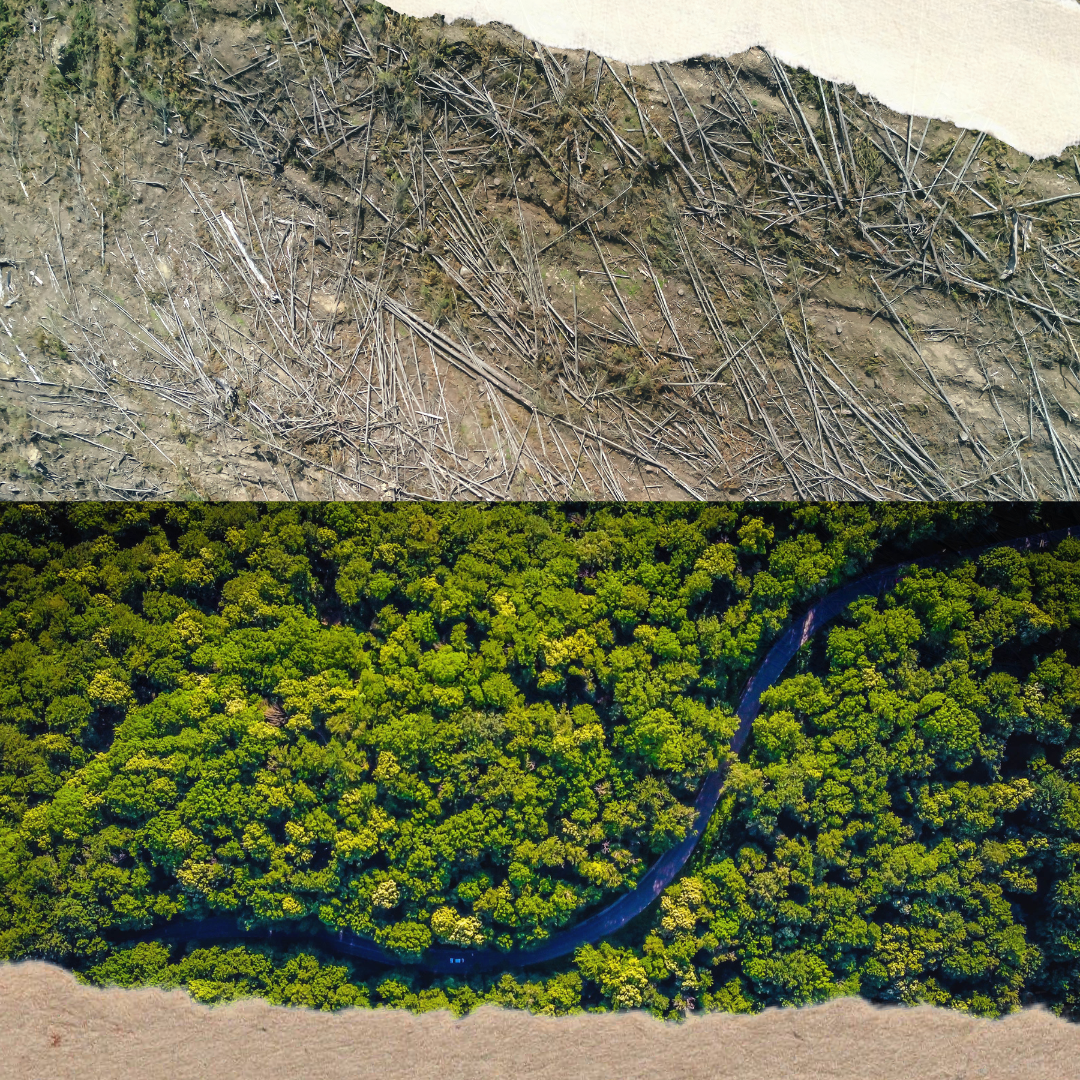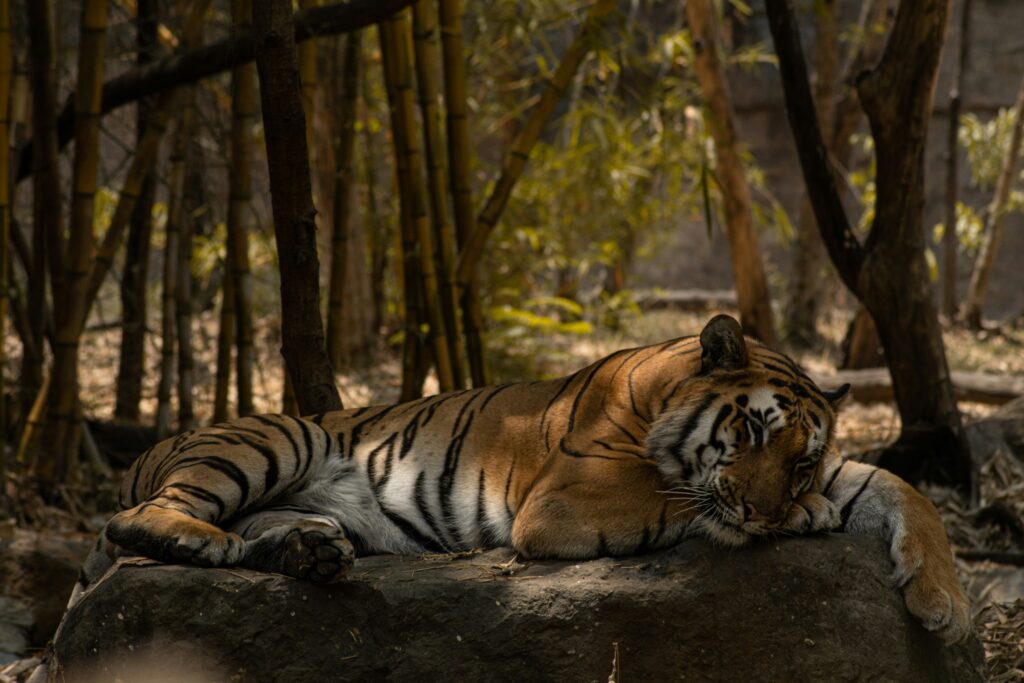Rainforest conservation, man vs nature?

In 2019 the vibrant, urban life in São Paulo came to a halt. The cause? A fire of unprecedented proportions raged in the Amazon rainforest, located 2700 km north of the city. Large, ominous columns of smoke obscured the vast white cityscape of the metropole. In the following weeks “the Lungs of the Earth are on fire!” was a phrase often heard in daily conversations as well as in the media. It even made an appearance on the French president Emmanuel Macron’s twitter.
The ecological cycles of the oxygen-producing rainforest had come under duress. It was as if the ashes that settled on the vast green space prompted a shortness of breath that could be felt around the world. Bleak images of the black skeletons of once lush trees found their way onto many screens worldwide, powerfully addressing the severity of the situation.
Globally, rainforests account for 30% of CO2 uptake. As a result, they are seen as a crucial puzzle piece in solving the climate crisis. Not unimaginable then, that international attention is increasingly turned towards preventing deforestation in the Amazon region. After all, phrases like “the Lungs of the World”, show that the public considers the Amazon as international property. They show that the forest does not just belong to the countries in which it is located. The importance of protecting the forest is therefore finding more resonance in international regulations.
Protection of the rainforest
In 2007, the United Nations Framework Convention on Climate Change (UNFCCC) launched a new set of nature protection programs specifically aimed at protecting the rainforest. The programs grant carbon credits to national governments and landowners, which can be obtained through conserving the forest by halting deforestation. These carbon credits can then be sold and traded on international markets to post-industrial countries to provide compensation for their emissions. The system aims to demonstrate an intention of compensating emissions.
If you’re interested in reading more about the UNFCCC, read also our article about the latest climate convention, COP28.
Challenges and pitfalls
At first glance this might appear as a benevolent endeavor. However, this system comes with some profound issues. The hyper-fixation on reduction of CO2, backed by phrases as “Lungs of the Earth”, has led to a blurry and complicated system of carbon credits. First of all, this labyrinth of regulations is often far from being effective due to many stakeholders. These stakeholders are different actors and parties who are active on local, national and global scales. The difficulties that come with coordination of interests across these scales, have made the development of a coherent strategy challenging.
Secondly, the persistent focus on preserving trees sends out the message that countries such as Brazil and Indonesia insufficiently tackle deforestation in their rainforests. These countries are therefore perceived to deserve the lion share of the blame. However, the actual main causes like excessive consumption patterns in the Global North are thereby forgotten or ignored. Thus, the real culprits move out of focus. This greatly limits our potential to effectively deal with the climate crisis. Moreover, it strains countries such as Brazil with the responsibility to right the wrongdoings of other countries.
Thirdly, the idea that it is possible to offset emissions of for example industrial activity by preventing trees to be cut down in the future is faulty. It is derived from the crooked reasoning that the carbon stored in trees equals the carbon released in the air by the fossil industry. In this regard, the notion of carbon compensation provides close to zero incentive to fundamentally halt destructive practices. Thus, presenting a possibility to continue emissions within the same system. It even provides a legal strategy for large corporations to acquire large parts of the Amazon, echoing colonial motifs.
Effect on indigenous communities living in the rainforest
But there’s more to the story. The rainforest as a holistic system embodies more than an infinite canopy of green and the occasional capybara. The rainforest also encompasses the territory of a large number of indigenous communities.
In Western thinking, nature is often thought of as being a separate entity from man. Nature conservation is therefore often best realized in the absence of man. However, indigenous philosophies often depart from a different perspective. Here, nature is actually intrinsically linked to man and they are placed on an equal footing. Human beings are embedded in the orderly design of nature and should practice reciprocal relations with the natural realm. Western philosophies on the other hand, regard the human-nature relationship from a human-centered hierarchical vantage point that omits elements of reciprocity. This Western line of thinking is reflected in carbon credit conservation programs. These often fail to consider the rainforest holistically while simultaneously encompassing habitat and territory.
One of the UNFCCC initiatives: REDD+
Through programs such as REDD+ (Reducing Emissions from Deforestation and forest Degradation plus sustainable forest management, forest conservation and enhancing forest carbon stock), one of the UNFCCC initiatives, many indigenous communities in the Amazon have been displaced. They, as a result of REDD+, now have decreased access to the forest due to vague formulation of property rights. Additionally, there is now a presence of armed guards to protect the REDD+ defined forest areas. This has also put a considerable strain on the freedom of indigenous people and their livelihoods. Whenever indigenous participation is used for conservation, it often happens without compensation and fails to grant the communities true decision-making power.
The ways in which nature is portrayed and the discourse we use to describe it, dictate how it is regulated. Visions of the Amazon that fail to consider the complex interactions between man and nature contribute directly to a one-dimensional conservation approach. That being: conservation as equaling the demarcation of areas of rainforest to reserve them for protection. Carbon credits thus are the embodiment of the stance that nature is a separate domain from humans. This allows nature to be turned into a commodity that can yield profits. Carbon credit programs also lack proper attention to and validation of indigenous knowledge. These are, however, indispensable for effective and meaningful conservation since they can create a mutually beneficial relationship between nature and humans. In short, now the rainforest protection efforts often do more harm than good.
A similar case: the tiger in the Indian rainforest

Another poignant case that is grounded in the same rationales is that of India’s conservation of its national animal, the tiger. Here, the state-led conservation of the tiger increases the marginalization of indigenous communities. This is because the conversation approach is too entrenched in a dualist perspective on human-nature relations, heavily influenced by Western education and Christianity.
This has problematic consequences for various Indigenous communities that see their territories becoming transformed into Tiger Reserves. These are founded on the pursuit of a pristine nature uninterrupted by human activity. Consequently, the establishment of these reserves limits access to the forest and therefore the freedom and livelihood of indigenous communities. This also encroaches on the enactment of the cultural rights of the Mishmi, Arunachal Pradesh and Jeru Kenuba people. The Jeru Kenuba people even feel as if they are living in an open air prison rather than in a natural area. They are perceived, by local guards, as intruders in the area that is reserved for wild animals. Contrastingly, the community members feel as if they know the forest better than anyone.
Indigenous feelings towards the tiger
How beneficial this approach is for the tigers in the long run, remains up in the air. Prior to the establishment of new reserves, many tribes have maintained tight relationships with the tigers and refer to them as brothers. In case a tiger threatens the safety of the community, some tribes resort to killing or trapping their problematic brother. However, this puts them directly at odds with the regulations imposed by the state. This causes resentment from local communities towards state policies and helps construct the idea that wildlife is government property. In turn, this will eventually result in decreased acceptance of wildlife populations outside of reserves, with all its detrimental consequences. The insistence upon the isolation of wildlife from local communities thus further drives a wedge between human and nature and will make sustainable co-existence more rare.
Conclusion
The knowledge that we do not exist in isolation of the nature surrounding us has slowly started to dawn in the Global North. Our dependence on nature’s resources has led to its demise thereby spelling our demise as well. The intrinsic need of our economic system to exploit different domains of life without replenishing them has led to the current climate crisis. However, there is still minimal awareness on our co-dependence on nature and how we can co-exist more sustainably.
The above shows that supposed solutions, rooted in a human-nature dualism, fail to be benevolent for all parties involved. This hinders the possibility to create new alliances and prevents the appreciation of knowledge crucial for mitigating the crisis. All of this warrants a need to revalue our relationship with nature and our position in it. Additionally, we need a commitment to valorize those who have maintained sustainable and healthy relationships with their natural surroundings. Future conservation efforts should therefore avoid the will to place mankind above and beyond nature. Additionally, it should steer clear from the desire to combine conservation with a profit motive. Rather, it should draw on those types of knowledge that have recognized the diversity of stitches that join us to the planet. It might just give us a good shot at stopping our home from going up in flames.
